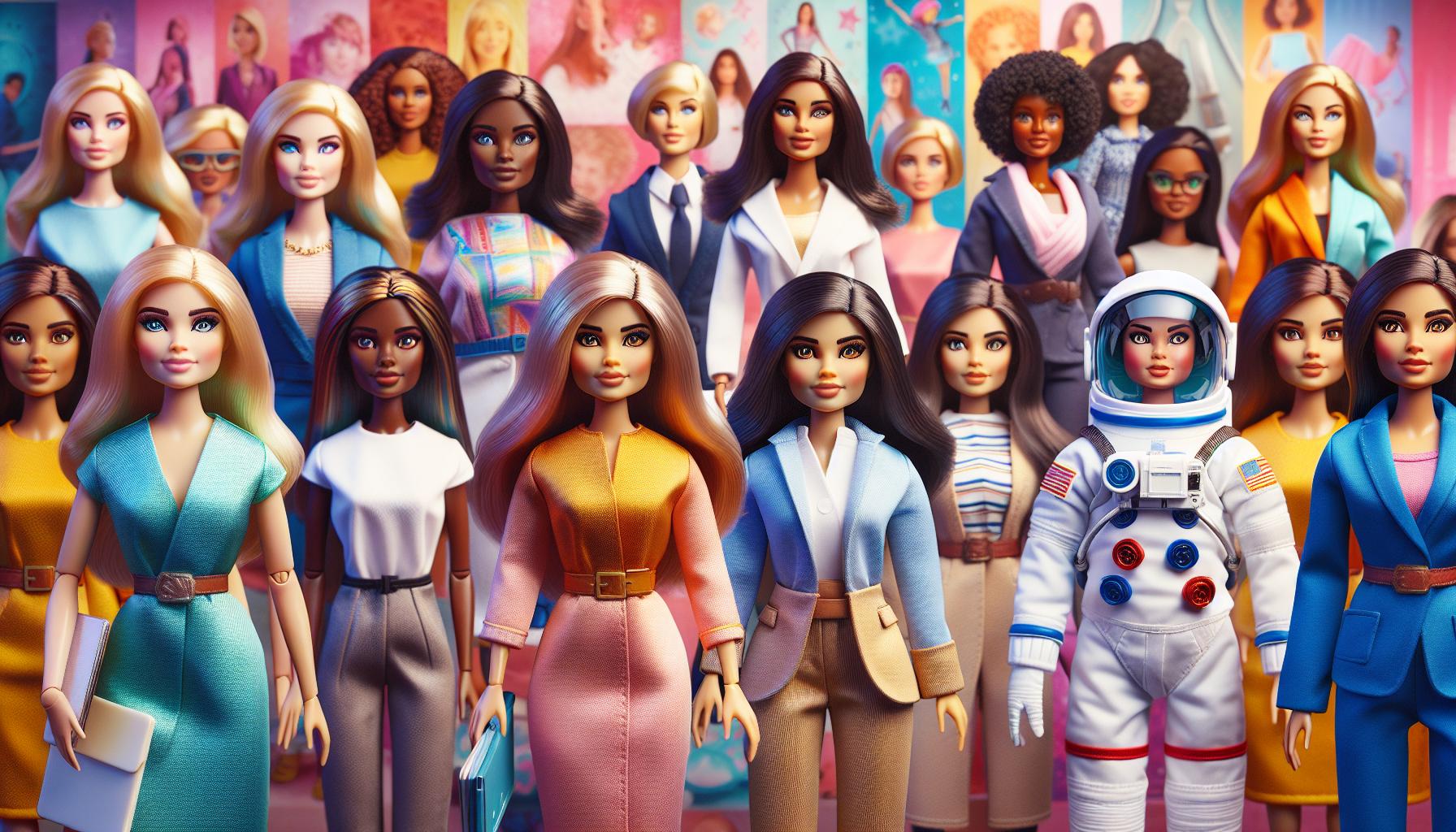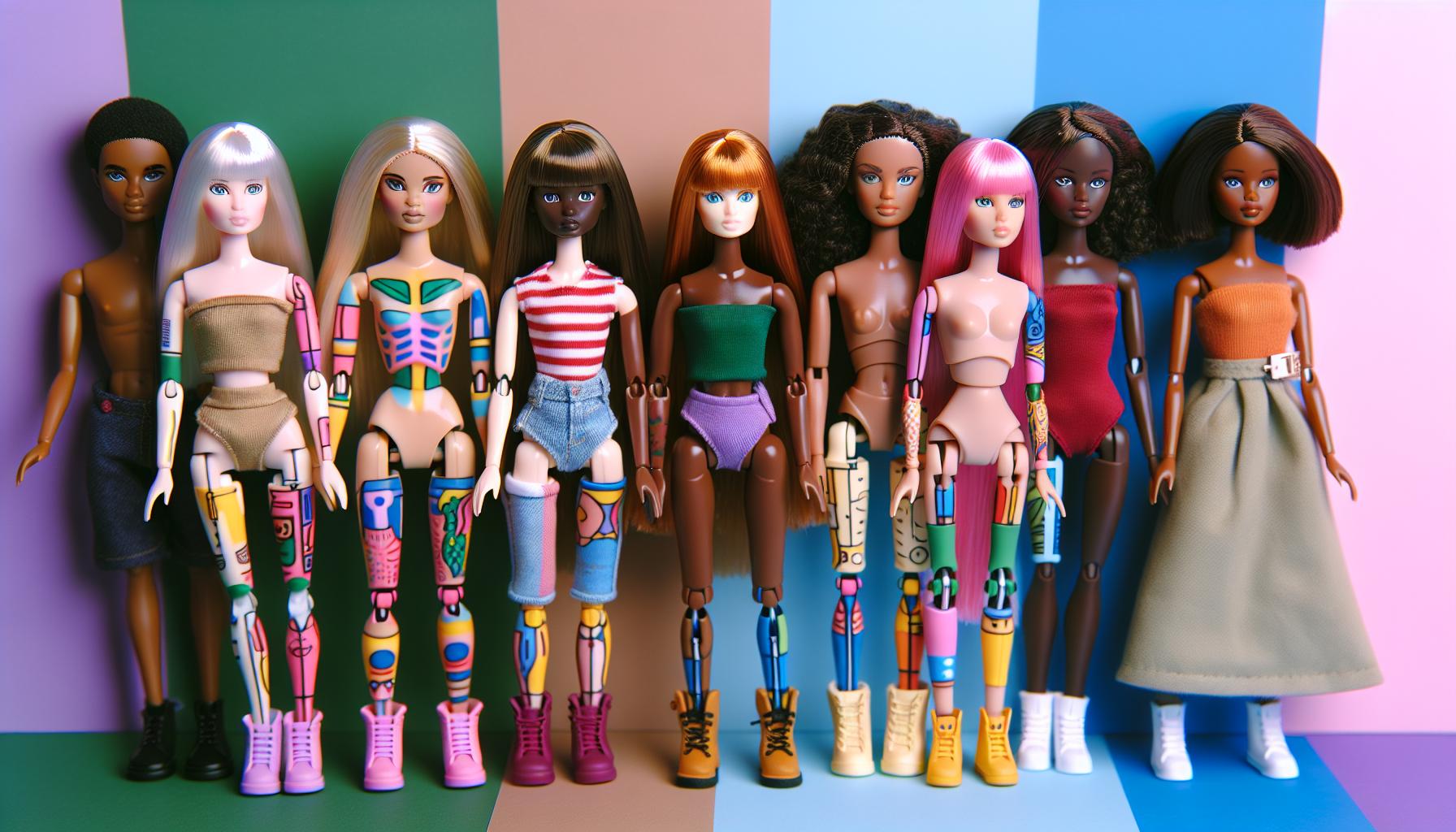I’ve always been fascinated by the cultural impact of Barbie, the iconic doll that’s been shaping childhoods for generations. Since her debut in 1959, Barbie has become more than just a toy; she’s a global phenomenon that’s constantly evolving to reflect changing societal norms and values.
In this article, I’ll explore the history, controversies, and enduring appeal of Barbie. From her groundbreaking career choices to her diverse range of body types and ethnicities, we’ll dive into how this plastic icon has managed to stay relevant for over six decades. Whether you’re a longtime fan or a curious observer, there’s no denying Barbie’s influence on popular culture and the toy industry.
Doll:di9ydr7tygq= Barbie
- Barbie has been a cultural icon for over 60 years, reflecting changing societal norms and values through her evolving designs and career choices.
- The doll’s impact extends beyond playtime, inspiring career aspirations and challenging beauty standards through increased diversity in body types and ethnicities.
- Barbie has faced controversies regarding unrealistic body proportions and representation, leading to the introduction of more inclusive doll designs.
- In the digital age, Barbie maintains relevance through movie adaptations, social media presence, and addressing contemporary social issues.
- Collecting Barbie dolls has become a popular hobby and potential investment, with rare editions fetching significant prices at auctions.
The Iconic Barbie Doll: A Timeless Classic
Barbie’s enduring popularity spans over six decades, making her a true icon in the toy industry. Since her debut in 1959, Barbie has captivated generations of children and collectors alike. Her versatility and adaptability have allowed her to remain relevant in an ever-changing world.
Barbie’s influence extends far beyond playtime. She’s a cultural touchstone, reflecting societal trends and aspirations. From fashion to career choices, Barbie has evolved alongside the changing roles of women in society. Her wardrobe has included everything from classic 1950s dresses to modern professional attire, mirroring real-world fashion trends.
One of Barbie’s most significant impacts is her role in inspiring career aspirations. She’s held numerous professions, including:
- Doctor
- Astronaut
- Teacher
- CEO
- Athlete
This diversity in career choices has encouraged children to dream big and consider various professional paths.
Barbie’s physical appearance has also undergone significant changes over the years. Mattel, the company behind Barbie, has introduced dolls with different body types, skin tones, and hair textures to better represent diverse populations. These changes include:
| Year | Introduction |
|---|---|
| 2016 | Curvy, petite, and tall body types |
| 2017 | Ken dolls with diverse body types |
| 2019 | Barbie Fashionistas line with wheelchair and prosthetic limb |
Despite facing criticism for promoting unrealistic beauty standards, Barbie has made strides in inclusivity and representation. The doll’s evolution reflects a broader societal shift towards embracing diversity and challenging traditional beauty norms.
Collectors value vintage Barbie dolls for their historical significance and rarity. Some early editions have become highly sought-after items, fetching impressive prices at auctions. This collectibility factor adds another dimension to Barbie’s enduring appeal, attracting adult enthusiasts alongside her core audience of children.
Barbie’s impact on popular culture is undeniable. She’s been featured in animated movies, video games, and even live-action films. Her recognizable brand has led to collaborations with various industries, from fashion designers to theme parks, further cementing her status as a cultural icon.
Evolution of Barbie Through the Decades
Barbie’s journey through the decades reflects societal changes and cultural shifts. Her transformations mirror evolving beauty standards, career aspirations, and cultural diversity.
1960s: The Birth of an Icon
The 1960s marked Barbie’s debut and rapid rise to popularity. In 1959, Ruth Handler introduced the first Barbie doll at the New York Toy Fair. Key features of 1960s Barbie include:
- Blonde hair, blue eyes, and a curvy figure
- Fashion-forward outfits inspired by popular styles
- Introduction of boyfriend Ken in 1961
- Career-oriented dolls like Nurse Barbie and Executive Career Girl Barbie
1970s-1990s: Expanding Diversity and Careers
During these decades, Barbie underwent significant changes to reflect societal progress:
- 1980: First African American and Hispanic Barbies introduced
- 1985: Day-to-Night Barbie showcased work-life balance
- 1992: Teen Talk Barbie sparked controversy with phrases like “Math class is tough!”
- 1997: Barbie’s body mold modified for a more realistic waist
Career options expanded to include:
- Doctor
- Astronaut
- Presidential candidate
- WNBA player
2000s-Present: Embracing Inclusivity
Recent years have seen Barbie embrace diversity and inclusivity:
- 2016: Introduction of Fashionistas line with different body types (tall, petite, curvy)
- 2017: First Barbie wearing a hijab (modeled after Olympian Ibtihaj Muhammad)
- 2019: Barbie Wheelchair and Barbie with Prosthetic Limb launched
- 2020: Diverse Ken dolls introduced with various body types and skin tones
- 2022: Barbie with hearing aids and Ken with vitiligo added to the lineup
- Over 175 looks with different skin tones, hair textures, and body types
- Representation of various ethnicities and cultures
- Career dolls reflecting modern professions like robotics engineer and video game developer
Barbie’s Cultural Impact and Influence

Barbie’s influence extends far beyond the toy aisle, shaping cultural norms and societal expectations. Her impact on fashion, gender roles, and popular culture has been both celebrated and critiqued, making her a subject of ongoing discussion and analysis.
Fashion and Style Trendsetter
Barbie’s wardrobe has consistently reflected and influenced fashion trends since her debut. Her outfits, designed by top fashion designers, have mirrored real-world styles from each era. In the 1960s, Barbie sported mod-inspired looks, while the 1980s saw her in power suits and neon colors. Today, Barbie’s fashion choices include sustainable and diverse options, promoting eco-consciousness and inclusivity. Collectors seek vintage Barbie outfits, with some rare pieces fetching thousands of dollars at auctions. The doll’s influence on fashion extends to real-world collaborations, inspiring clothing lines and accessories for both children and adults.
Breaking Gender Stereotypes
Barbie has played a significant role in challenging traditional gender roles. Since the 1960s, Barbie has represented over 200 careers, including traditionally male-dominated fields like astronaut, surgeon, and computer engineer. In 1965, Barbie became an astronaut four years before Neil Armstrong walked on the moon. The “You Can Be Anything” campaign, launched in 2015, further emphasized Barbie’s role in empowering girls to pursue diverse career paths. Recent additions to the Barbie lineup include dolls representing STEM fields, political leaders, and entrepreneurs, encouraging children to envision themselves in these roles. Critics argue that Barbie’s emphasis on appearance contradicts her career-oriented message, sparking ongoing debates about the doll’s impact on gender stereotypes and body image.
Controversies and Criticisms Surrounding Barbie

Barbie’s iconic status hasn’t shielded her from controversy. Throughout her 60-year history, the doll has faced numerous criticisms, primarily focused on body image and representation issues.
Body Image Concerns
Barbie’s unrealistic body proportions have been a source of ongoing debate. Critics argue that her exaggerated figure promotes unhealthy beauty standards for young girls. Studies have shown that if Barbie were a real woman, she’d be 5’9″ tall, weigh 110 pounds, and have a 16-inch waist – dimensions that are physically impossible. This idealized body type has raised concerns about its potential impact on children’s self-esteem and body image. In response, Mattel introduced new body types in 2016, including curvy, petite, and tall Barbies, to better reflect diverse body shapes.
Representation Issues
Barbie’s initial lack of diversity sparked criticism about racial and ethnic representation. For decades, the doll primarily portrayed a white, blonde, blue-eyed ideal of beauty. Mattel addressed these concerns by introducing dolls of different ethnicities, starting with African American and Hispanic Barbies in the 1980s. However, critics argue that these efforts were often tokenistic and didn’t adequately represent the full spectrum of diversity. Recent years have seen improvements, with Barbie lines featuring dolls with various skin tones, hair textures, and cultural backgrounds. The Fashionistas line, for example, now includes dolls with vitiligo, prosthetic limbs, and wheelchairs, aiming to broaden representation and inclusivity.
Barbie’s Enduring Popularity in the Digital Age
Barbie’s iconic status has seamlessly transitioned into the digital era, maintaining her relevance and appeal to new generations. Her adaptability to modern platforms and media has allowed her to remain a cultural touchstone, engaging with fans in innovative ways.
Movie and TV Adaptations
Barbie’s presence in movies and TV has significantly boosted her popularity in the digital age. Mattel’s strategic partnerships with major studios have resulted in numerous animated films and series, keeping Barbie at the forefront of children’s entertainment. The 2023 live-action Barbie movie, directed by Greta Gerwig and starring Margot Robbie, generated unprecedented buzz and reignited interest in the brand across all age groups. These adaptations not only entertain but also showcase Barbie’s evolving narratives, addressing contemporary themes and values.
Social Media Presence
Barbie’s social media strategy has been crucial in maintaining her relevance in the digital landscape. With millions of followers across platforms like Instagram, TikTok, and YouTube, Barbie’s official accounts provide a mix of nostalgic content, new product announcements, and empowering messages. The brand leverages user-generated content, collaborations with influencers, and content creators, and interactive campaigns to engage with fans of all ages. Barbie’s digital presence extends beyond marketing, often addressing social issues and promoting diversity, further solidifying her role as a modern cultural icon.
Collecting Barbie: A Hobby and Investment
Barbie collecting is a passion that combines nostalgia, art appreciation, and potential financial gain. I’ve seen collectors amass impressive arrays of dolls, from vintage treasures to limited-edition releases. The hobby’s appeal lies in the doll’s rich history and cultural significance, with some rare Barbies fetching tens of thousands of dollars at auctions.
Identifying Valuable Barbies
Recognizing valuable Barbies requires knowledge of production dates, rarity, and condition. I’ve found that the most sought-after dolls include:
- First Edition Barbie (1959)
- Barbie #1 (1959-1960)
- Blonde Ponytail Barbie #3 (1960)
- Brunette Ponytail Barbie #3 (1960)
- Barbie #4 (1961)
Condition is crucial in determining value. Mint-condition dolls in original packaging command premium prices. Rarity, unique features, and historical significance also contribute to a doll’s worth.
Building a Collection
Starting a Barbie collection involves:
- Researching Barbie’s history and valuable editions
- Setting a budget and collection focus
- Networking with other collectors and joining collector groups
- Attending toy fairs, conventions, and auctions
- Verifying authenticity through reputable sources
I recommend beginners start with modern collectibles and gradually expand to vintage dolls as they gain experience.
Preserving and Displaying Barbies
Proper preservation ensures your collection retains its value. Key preservation techniques include:
- Storing dolls in acid-free boxes or display cases
- Keeping them away from direct sunlight and humidity
- Handling dolls with clean, dry hands or cotton gloves
- Avoiding exposure to extreme temperatures
Display options range from custom-built shelving units to professional-grade museum cases, depending on your collection’s size and value.
Investment Potential
While not all Barbies appreciate significantly, certain dolls have proven to be lucrative investments. Factors affecting investment potential include:
- Limited production runs
- Commemorative editions
- Designer collaborations
- Historical significance
| Barbie Edition | Release Year | Original Price | Current Value (Approx.) |
|---|---|---|---|
| #1 Barbie | 1959 | $3 | $8,000 – $25,000 |
| De Beers Barbie | 1999 | $85,000 | $300,000+ |
| Stefano Canturi | 2010 | $302,500 | $500,000+ |
These values demonstrate the potential for significant returns on investment for rare and sought-after Barbies.
Global Culture
Barbie’s journey from a simple doll to a global cultural phenomenon is truly remarkable. She’s weathered criticism evolved with the times and continues to inspire generations. As we look to the future I’m excited to see how Barbie will adapt to new challenges and opportunities. Her enduring popularity proves that she’s more than just a toy – she’s a reflection of our society’s dreams aspirations and ongoing conversations about representation and empowerment. Barbie’s story isn’t over and I can’t wait to see what she’ll do next.

